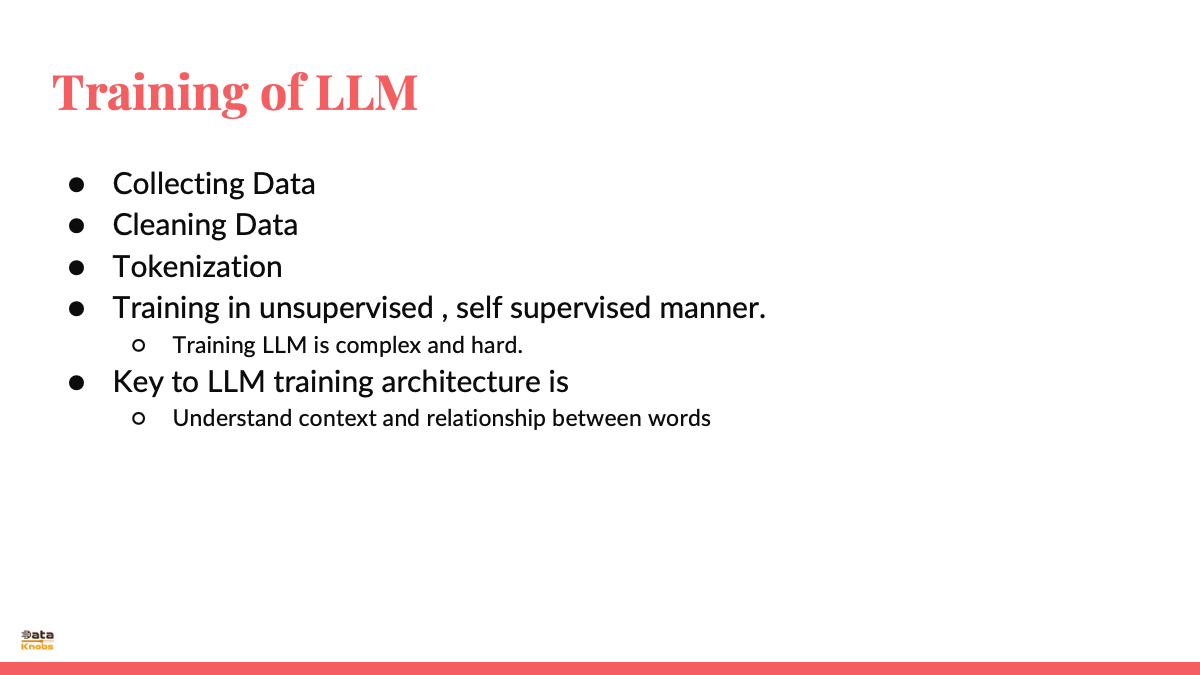Slide60

|
Foundation LLMs (Large Language Models) are the powerhouses behind many of today's impressive AI feats, from generating realistic text to translating languages. But training these marvels takes a lot more than just feeding them text. Let's dive into the key ingredients that go into building a foundation LLM. Data, the Fuel of Learning:The foundation of any LLM is the data it's trained on. These models require massive amounts of text data, often scraped from books, articles, code repositories, and even the vast corners of the internet. This data needs to be diverse, encompassing a wide range of writing styles and topics to equip the LLM with a broad understanding of language. Preparing the Textual Feast:Raw text isn't fed directly to the LLM. Data scientists perform a process called tokenization, breaking down the text into smaller units like words or phrases. This allows the model to understand the building blocks of language. Additionally, data cleaning might be necessary to remove biases or errors that could skew the model's learning. The Learning Algorithm: Unsupervised AdventuresUnlike supervised learning where models are trained on labeled data, foundation LLMs utilize unsupervised learning. Here, the model sifts through the massive dataset, identifying patterns and relationships between the tokens. This allows the LLM to grasp the nuances of language structure, like grammar and sentence flow, and begin to develop an understanding of the world through the statistical relationships found in text. The Training Powerhouse: A Matter of MuscleTraining a foundation LLM is a computationally expensive task. These models have millions, sometimes billions, of parameters that need to be adjusted based on the data. This requires specialized hardware, often clusters of powerful GPUs, to handle the immense calculations involved. Evaluating the Mastermind: Is it Learning?Once trained, the LLM's performance is evaluated on various tasks. This might involve testing its ability to complete sentences, translate languages, or answer questions in a comprehensive way. Based on these evaluations, the model might be further fine-tuned to improve its performance in specific areas. The Road Ahead: Beyond the BasicsFoundation LLMs are the groundwork for even more specialized AI models. By fine-tuning these models on specific tasks, developers can create applications for machine translation, writing assistance, or even code generation. As research continues, the capabilities of foundation LLMs are expected to grow even further, pushing the boundaries of what AI can achieve. |
|
Large Language Models (LLMs) have become the darlings of the AI world, capable of generating human-quality text, translating languages, and even writing different kinds of creative content. But training these marvels is no walk in the park. Let's delve into the intricate steps involved in crafting an LLM:
1. The Information Feast: Data CollectionThe journey begins with data. LLMs require a vast and varied diet of text, often culled from books, articles, code repositories, and the sprawling web. Diversity is key here; the more writing styles and topics the model encounters, the richer its understanding of language becomes.2. Scrubbing the Mess: Data CleaningRaw text isn't fed directly to the LLM. It needs a good scrubbing first. Data scientists perform a process called tokenization, breaking down the text into smaller, digestible units like words or phrases. This allows the model to understand the building blocks of language. Additionally, data cleaning might be necessary to remove biases or errors that could skew the model's learning.3. Unsupervised Learning: The Model Discovers on Its OwnUnlike supervised learning where models are trained on labeled data (think "cat" next to a picture of a cat), LLMs embark on an unsupervised learning adventure. Here, the model sifts through the massive dataset, identifying patterns and relationships between the tokens. This allows the LLM to grasp the nuances of language structure, like grammar and sentence flow. It essentially starts to understand the world through the statistical connections found in text.4. Self-Supervised Learning: Teaching Through PlayBut unsupervised learning isn't the whole story. Many LLMs also leverage a technique called self-supervised learning. Here, the model is given tasks like predicting the next word in a sequence or completing a cloze passage (filling in the blanks). By constantly getting feedback on its predictions, the model refines its understanding of language and its ability to process information.5. The Computational Challenge: Training Takes MuscleTraining an LLM is a computationally expensive task. These models have millions, sometimes billions, of parameters that need to be adjusted based on the data. This requires specialized hardware, often clusters of powerful GPUs, to handle the immense calculations involved. Fine-tuning these parameters is what ultimately allows the LLM to learn and improve.The Art of the Craft: Understanding Context is KingThe key to LLM training architecture lies in its ability to understand context and the relationships between words. By analyzing the data, the model learns not just the meaning of individual words, but also how they interact with each other to convey meaning. This allows the LLM to not only generate grammatically correct text, but also text that is coherent and relevant to the situation.The Road Ahead: A Perilous PathTraining LLMs is complex and fraught with challenges. Biases can creep in from the data, and ensuring the model generates safe and non-offensive text requires careful consideration. However, the potential rewards are vast, pushing the boundaries of what AI can achieve and opening doors to exciting new applications. |